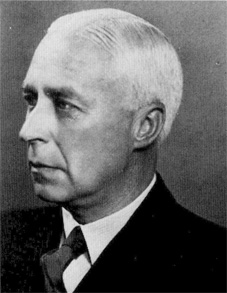| Profile | Major Works | Resources |
Erik R. Lindahl, 1891-1960.

Probably the most theoretically rigorous member of the Stockholm School, Erik Robert Lindahl was the only member of that group who stayed wholly within academia.
Erik Lindhal obtained his degree at University of Lund 1919 and was highly influenced by Knut Wicksell (although Wicksell had already left Lund, he helped oversee Lindahl's thesis). Lindahl stayed on as a instructor at Lund until 1924, when he moved to Uppsala. He finally obtained a full chair at the Gothenburg Business School in 1932, but abandoned it to take up Wicksell's old chair at Lund in 1939 (succeeding Somarin). Lindahl moved on again three years later, to take the chair at the University of Uppsala in 1942 (succeeding Brock), where he would remain until his retirement in 1958.
Lindahl's contributions to economic theory extend beyond his Wicksellian roots to anticipate much of what is contained in modern Neo-Walrasian equilibrium theory. Lindahl's formulation of the concept of sequence economies and intertemporal equilibrium (1929, 1930) is by far the first rigorous attempt to do so. Lindahl's couching of a theory of capital (1929, 1939) in intertemporal terms anticipates Malinvaud's (1953) famous attempt. The transfer of Lindahl's concepts to the anglophone world was accomplished by two of his most ardent supporters, John Hicks (1939, 1965) and Friedrich Hayek (1941). Since then, his work on "sequence analysis" has been given greater emphasis since the work of Frank Hahn (1973) and Roy Radner (1972). Lindahl's 1919 solution to the pricing of public goods is another noticeable achievement, brought into modern economic by Duncan Foley (1970).
|
Major works of Erik Lindahl
|
HET
|
|
Resources on Erik Lindahl
|
All rights reserved, Gonšalo L. Fonseca
